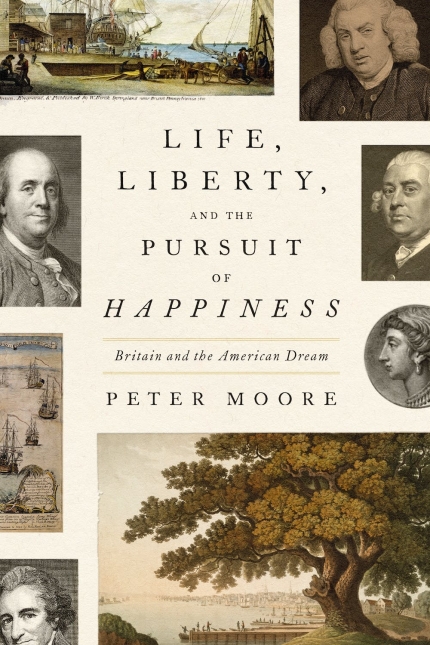Life, Liberty, and the Pursuit of Happiness: Britain and the American Dream
- By Peter Moore
- Farrar, Straus and Giroux
- 572 pp.
- Reviewed by William Rice
- July 18, 2023
A persuasive claim that Yankee feistiness was born across the pond.

Lifelong Americans are presented in our youth with a national origin story as sacred and singular as the Nativity. That early impression makes it hard to accept the American Revolution as just one component of a larger political movement. Yet that’s the perspective British author Peter Moore successfully urges in Life, Liberty, and the Pursuit of Happiness: Britain and the American Dream. He argues, in essence, that American patriots were not so much rejecting British ideas of government as fulfilling them.
Moore uses connections between individual Americans and Britons as a stand-in for the complex relationship between the colonies and Mother England. The central one is between two printers turned politicians: Philadelphian Benjamin Franklin and Londoner James Strahan. Franklin, of course, is an international icon, but few readers in the U.S. or Britain today know Strahan, even though he was the most important publisher in the 18th-century, English-speaking world. Among the titles rolling off his presses: Adam Smith’s The Wealth of Nations and Edward Gibbon’s The Decline and Fall of the Roman Empire (both in 1776, in fact), not to mention Samuel Johnson’s groundbreaking dictionary.
Franklin is the book’s anchor, and for good reason. He was an American thought leader living at the center of London’s political and literary tumult for almost 15 crucial years leading up to the War of Independence. He embodied the rags-to-riches trajectory thought of as purely an American ideal but one that Moore argues a stratified British society was beginning to cheer. Franklin’s renowned experiments with electricity were part of the era’s embrace of science that altered perceptions of civilization and government. Though he spent almost the final third of his life as an expatriate, he had the unerring ability to return to America when it mattered (1776 and 1787). Finally, he lived to the age of 84 — a lifespan covering fully half the history of British America at the time.
Johnson is another key character here. A charismatic curmudgeon who once described “all change” as “evil,” he nonetheless found his way early to the right side of a lot of issues. Noting the bitter irony of American slaveholders demanding freedom from British tyranny, he famously wondered “why we hear the loudest yelps for liberty among the drivers of negroes?” He also disapproved of stealing land from Indigenous peoples, describing the struggle between the British and French over North America as “the quarrel of two [highway] robbers for the spoils of a passenger.”
The culmination of that quarrel was the Seven Years’ War, known in America as the French and Indian War. It ended in a great victory for the British in Europe and the New World but also wound up disrupting settled arrangements in both places. War fatigue and a new king ended a 40-year lock on government by the progressive Whig party in Great Britain, while London tried to cover its huge war debts by directly taxing the colonies for the first time. We all know how well that went over — even though it was not an entirely unreasonable idea given that royal troops had, by ridding North America of French power, eliminated the biggest threat to the colonists.
Another key figure in the story is the British radical (and rascally) writer and politician John Wilkes, who became an unlikely symbol of liberty on both sides of the Atlantic. He began as a political hatchet man hired by Whig operatives to write biting parodies of the conservative Tory government. Even though, in the style of the day, his barbed commentaries were printed anonymously, he was eventually found out and ended up in the Tower of London. But just like certain pols today, instead of letting entanglements with the law end his career, Wilkes exploited them. He claimed — though it’s unclear how sincerely — that his prosecution was proof the vaunted British concept of liberty was under threat, thereby winning him adoring fans and a victory at the ballot box.
Moore offers ample proof that the revolution in America had British roots. When Wilkes stood for Parliament, some of his raucous supporters were called “Sons of Liberty” — the same name used by Boston’s Tea Partiers. John and Abigail Adams were early correspondents with pioneering female historian Catherine Macaulay, a liberal British polemicist who took up the American cause. Moore further notes that earlier historians pointed out Thomas Jefferson’s ownership of a pamphlet by Johnson containing the phrase “pursuit of happiness.”
For all that, the book is a bit overstuffed and rambling. As magical as it is (at first) to learn small details of social interactions over a quarter-millennium old, after a while, mundane events are just mundane, whatever century they occurred. But some of the minutiae Moore provides is fascinating: details of the pre-industrial printing process, for instance, and the logistical difficulties of the hated Stamp Act.
Acknowledging that the American Revolution was not a radical break with the British political system but one important manifestation of its evolution does not diminish its importance. It does, however, allow us to usefully replace the supernatural concept of “American exceptionalism” with a more nuanced, global view of human progress.
William Rice is a writer for political and policy-advocacy organizations.

_80_124.png)